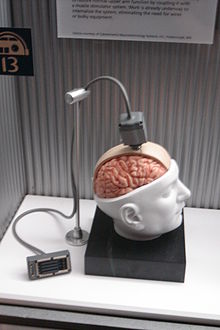- Cyberkinetics
-
Cyberkinetics is an American company. It was cofounded by John Donoghue, Mijail Serruya, and Gerhard Friehs of Brown University and Nicho Hatsopoulos of the University of Chicago. The Braingate technology and related Cyberkinetic’s assets are now owned by privately held Braingate, LLC.[1] Their work helped develop early-stage bionics in the form of implantable electronic devices and now spinoff Cyberkinetics is taking the technology several steps further. The Food and Drug Administration (FDA) has approved a clinical trial to implant the BrainGate technology into five severely disabled patients to determine if they can use the technology to send simple computer commands through channeled thought.
Contents
Funding
Scientists behind the project used $9.3 million in first round funding led by Oxford Bioscience Partners. A 2002 merger with Bionic Technologies, co-founded by Brian Hatt and Richard Normann (the inventor of the Utah Array) added to a tech team armed with intellectual property rights gained from Brown, MIT, and others. They say they're three to five years away from putting a product on the market.
According to their latest SEC filing, the Founders of the company resigned from the Board of Directors at the end of October, 2008.
Merger & Renaming
In late 2004, Cyberkinetics initiated a reverse merger with a Texas company in order to gain access to the public market. The resulting company was renamed Cyberkinetics Neurotechnology Systems, Inc. and its shares are listed under the symbol CYKN.OB. In 2009, the BrainGate business and related Cyberkinetic’s assets were sold to privately held Braingate, LLC.[2].
Clinical Trials
Update: July 8, 2009 Clinical Trials are now being conducted for the Brian Gate 2 Neural Interface System. Additional information on Brain Gate can be accessed at www.braingate2.org[3]
Update: July 16, 2009 The pilot clinical trial of the BrainGate2 Neural Interface System is registered at ClinicalTrials.gov; details can be viewed at the following location:
www.clinicaltrials.gov/ct2/show/NCT00912041[4]
Competitors
See also
References
- ^ Braingate gets a new lease on life, The Boston Globe, August, 2009
- ^ Braingate gets a new lease on life, The Boston Globe, August, 2009
- ^ [1]
- ^ [2]
External links
- Cyberkinetics Neurotechnology Official Website
- Donoghue Lab
- Hatsopoulos Lab
- Brain Gate Official Website
Categories: Brain-computer interfacing
Wikimedia Foundation. 2010.

